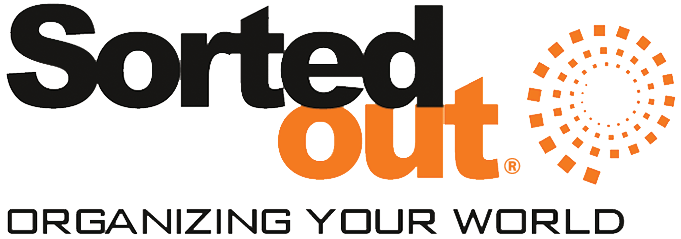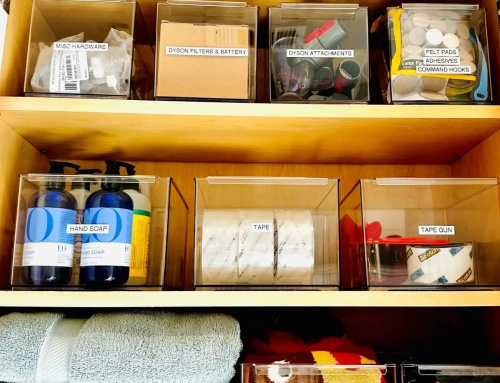
I think many of us would agree that keeping your own closets at home is a hard task as it is. But keeping a supply closet that you share with an entire team of people organized and tidy at all times? Next level difficult. Most offices, departments, building floors, or teams have some type of shared space intended to house collective supplies. Is this designated space in your office starting to look like a dumping ground? Is it an area that’s more “shut the door and hide the mess” than functional? Are you tired of needing something at work only to realize the stock has been used up? Let us walk you through the best way to organize this supply storage space and turn your company’s “cluttered mess” back into its “organized best”!
Start with a clean slate
You’ve decided to take back the space formerly known as the office supply closet! Yay! A key step when taking on a reorganization project is to give yourself the opportunity to start completely fresh.
First, remove everything.
Before you even begin thinking about where things should be located moving forward, you need to remove everything from its’ current home. Step one is to completely clear the space out. Wholly clean out the room or closet and get rid of anything you don’t need or no longer use. If your supply room is a large space, start clearing items out in one section and then work your way around the space in chunks so you don’t get too overwhelmed. Starting off with a clean slate will help immensely.
Group things into like items (or like-uses) to store together.
Once you have the space cleared out and cleaned, the next step is to group like supplies together. Depending on the business, the way the items are grouped should differ. Consider grouping by room (janitorial/bathroom, break room, office/stationary, etc.) or business processes (shipping/receiving, client type/inventory, general office supplies/backstock, etc.). If you group items based on the location of their use in the building, or by which process within the business they’re used in, it will help employees use the newly organized space with focus.
You’re also going to need to create a shopping list to obtain any containers, bins, or tools that are needed to organize the space. Measure any existing or provided storage racks/cabinets/shelves so that you know what size organization bins will fit best. We highly recommend that you use clear bins when possible. It is much easier to tell what you have in each area and to find items you need much quicker when the bins are clear. This will work well and be easily maintainable for all employees (especially those with ADHD)!
Once items are in their designated areas & containers: LABEL!
You’ve cleared the area out, logically grouped items together, and obtained the appropriate clear bins for the space. Good work! Before you begin haphazardly putting everything into the bins and back into the supply closet… label everything. By labeling every container you (and your employees) will know what items to return to each bin/shelf in the future. We recommend placing the label in the same spot on every bin (i.e. all labels centered in the middle, or, all labels in the upper righthand corner). This way, even new employees will see consistency and know where to look. Labels will also help when taking inventory and placing supply orders because you can easily look in the designated space for each item and see what your stock is.
Setup & organize
Now comes the part where you’ll start to see the fruit of your labors! Begin putting things back on the shelves, in the cabinets, etc. When deciding which items should be placed where, think about regularly used items vs. rarely needed items. Keep in mind which items are used most frequently; you’ll want to place those supplies in the most convenient spot for everyone. The items you need less often can go higher on the shelves, or in the cabinets, because you won’t need consistent access to them. It’s also important that when setting up the space you take the WEIGHT of items into consideration. If an item is particularly heavy, you don’t want to place it on a high shelf because then it will be more difficult to obtain or could cause a spill/injury. Heavier items should be on the bottom of shelving/racks, whereas something like rolls of paper towels would be fine on a top shelf.

Take Note of What You Have
Now that everything in the supply closet is organized and placed where it is most functional, you’ll want to take steps to ensure it stays organized!
Make a list of what your office uses regularly
Items used on a consistent basis will, of course, need to be regularly stocked. It’s important that you take note of each item’s frequency of use. Knowing which items are used daily, how many of each you currently have on hand, and how long one shipment of each will typically last is vital to your business’s productivity. You should also have a list of how many of each item you need, based specifically on how that particular item is ordered (ie: reams of paper, packages of pens, cases of envelopes, etc.). You’ll want to make sure that you always have “backup” extras so you never run out before the next shipment arrives.
Restocking & Keeping Supplies On Hand
Supply organization for a business requires more than knowing where items are located and what items are most frequently used. It is perhaps most crucial that you know how to ensure those supplies are always available for all employees.
Implement a process so that you can keep up with demand
Select a day each week to check your inventory. A weekly inventory will keep you in-the-know and alert to any supplies running low on stock. This will also help to ensure you don’t run out of needed materials prematurely.
Create an “order sheet”
Use this as you go through your inventory each week so you can simply write in the number of each item you have on hand and easily see how many you need to purchase to be fully stocked. (There are great apps such as “Sortly” that you can use if your company has a large-scale inventory or if you prefer an electronic-application. If you are more textile, like I am, a basic spreadsheet on a clipboard works great too!)
If you use a physical spreadsheet, have it on a clipboard and stored in plain sight near the storage space. If others in the office are able to order supplies, you want them to have direct access to it and be able to find the order sheet quickly/easily. If you seek out an electronic application, make sure the appropriate employees have the login information and direct access to the application (whether on a mobile phone, using an office tablet, etc.)
Create an order schedule for the best times to reorder/restock.
It is also important that your restocking process has a schedule. This will differ for every company, but needs to be based on your inventory budget, size of storage space, frequency of supply use, etc. Some businesses will place a supply order weekly, while others may have one routine restock scheduled per month. Keep shipping times in mind so that you don’t end up running out of something before the next shipment arrives. It’s always best to over-estimate on an order and plan to have extras on hand, just in case of delays (weather related, supplier out of stock, etc.)
An unorganized space and unclear stock procedures are only going to slow employees down. By organizing your company’s supply closet and creating processes for your supply inventory and restocking, you’ll see an increase in employee productivity. If you are able to keep the office both physically and methodically organized, your employees’ focus will be exactly where it needs to be. If you recognize the need for a more organized environment but think you’re in over your head at your company, don’t hesitate to reach out to us at info@sortedout.com . One of our business organizing professionals would be happy to help you get on the fast track to success!
Looking forward to hearing from you,
Tonia
Request a Consultation
There are so many ways that organization can help take back a space that is overwhelming and bring it to functional! We are excited to help start your journey to an organized and productive space.






